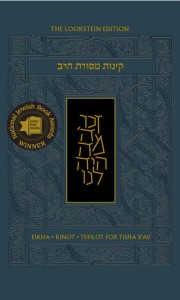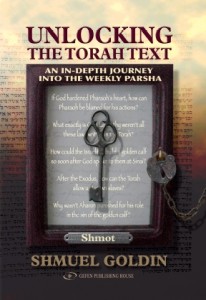Excerpted from Rabbi Shmuel Goldin’s ‘Unlocking The Torah Text: An In-Depth Journey Into The Weekly Parsha- Vayikra,’ co-published by OU Press and Gefen Publishers

Mysterious Majesty
Context
As Parshat Emor continues with its description of the festival cycle, we encounter a holiday shrouded in mystery.
A series of enigmas surround both the festival of Shavuot, introduced for the first time in this parsha, and Revelation, the historical event with which Shavuot is associated.
- Although the rabbis identify Shavuot as Zman Matan Torateinu, the anniversary of the giving of our Torah, no actual connection between the holiday and Revelation is made in the text. Shavuot, in fact, emerges as the only one of the three pilgrimage festivals (Pesach, Shavuot and Succot) for which no historical foundation is recorded in the Torah.
- At no point does the Torah mention an independent calendar date for the festival of Shavuot. Most often, this holiday is identified as the endpoint of the Omer count (see previous study). The festival’s very title, Shavuot (literally “Weeks”) derives from the celebration’s position as the culmination of the seven-week Omer period.On one occasion, in a series of passages clearly identifying the holidays by their calendar dates, Shavuot is again the glaring exception, with even the festival’s relationship to the Omer period omitted. In that case, Shavuot is mentioned without any calendar reference at all.
- The Torah also fails to pinpoint the specific date of the onset of Revelation at Sinai. The text, in fact, seems to deliberately go out of its way to avoid any clear dating of this event. The arrival of the Israelites at the site of Revelation is, for example, described in the Torah as follows: “In the third month from the Exodus of the children of Israel from the Land of Egypt, on this day, they came to the Wilderness of Sinai.”Failing to identify “this day,” the Torah leaves it to the rabbis to compute the chronology and explain that the Israelites arrive at Sinai on the first day of the third month, Sivan.To make matters even more confusing, uncertainty emerges concerning the timetable of events immediately prior to Revelation. Based on ambiguity in the text, the rabbis debate whether or not Moshe, divinely commanded to set aside three days preparatory to Revelation, “adds an additional preparatory day of his own.” This disagreement over Moshe’s actions, in turn, leads to an even more significant divergence of opinion concerning the exact date of Revelation.The majority of the rabbis, maintaining that Moshe followed God’s instructions to the letter, correlate the onset of Revelation to the sixth day of Sivan, the date of the Shavuot festival. Rabbi Yossi, however, the author of the position that Moshe added an additional preparatory day, insists that Revelation does not begin until the seventh day of Sivan – the day after Shavuot.According to Rabbi Yossi’s calculations, we are thus faced with the startling conclusion that Revelation does not occur on the date of the festival identified by the rabbis as the anniversary of the event. (In the diaspora, Shavuot is observed on the seventh day of Sivan, as well as the sixth. This observance, however, does not relate to the above discussion but is the result of a general rabbinic decree concerning calendar uncertainty: yom tov sheini shel galuyot, the added second day of observance of all the festivals in the diaspora.)
- Finally, in contrast to other festivals, no unique observance is associated in the text with the holiday of Shavuot (all-night learning sessions are a minhag, a custom, and not biblically or even rabbinically mandated). This festival is governed only by the generic laws common to all biblical holidays.
Questions
Why does so much mystery surround the festival of Shavuot and the commemoration of Revelation?
Shouldn’t the single most important formative event in Jewish history be clearly dated and uniquely celebrated?
Approaches
A
The Torah’s identification of Shavuot as the culmination of the Omer count, as opposed to a holiday with a separate calendar date of its own, may well reflect and expand upon lessons learned from the Omer period itself (see previous study).
As discussed, many authorities see the mitzva of Sfirat Ha’omer, the counting of the Omer, as an act linking Pesach to Shavuot. In this light, Shavuot is best understood, not as a totally autonomous festival, but as something of a “hybrid” – a continuation of Pesach, yet also a commemoration with its own unique identity and message. Shavuot stands as Pesach’s goal, a reminder that the physical freedom achieved with the Exodus is incomplete without the spiritual freedom granted at Sinai.
B
Unexpected precedent for this approach is found in the form of another two-tiered biblical festival, distant on the calendar from but in many ways similar to the festival of Shavuot.
Immediately after the holiday of Succot, the Torah mandates a one-day festival known as Shmini Atzeret. While this celebration is clearly connected to Succot, the rabbis are nonetheless emphatic in their contention that Shmini Atzeret is a “festival unto itself,” with its own identity and message. We are thus again confronted with a “hybrid holiday,” a celebration which, like Shavuot, is at once a continuation of what comes before (even the title Shmini Atzeret, the Eighth Day of Assembly, references the connection to the seven days of Succot) and at the same time a separate occasion.
Furthermore, while Shmini Atzeret and Shavuot stand at opposite ends of the calendar, rabbinic thought connects them closely. Shavuot is referred to within Talmudic literature simply as Atzeret, the Day of Assembly. Rabbi Yehoshua ben Levi even maintains that Shmini Atzeret should rightfully be as distant from Succot as Shavuot is from Pesach. Mercifully, however, God places Shmini Atzeret immediately following Succot so that the people will not have to make an additional pilgrimage back to Jerusalem during the winter season.
The implied equation is clear: Shavuot is to Pesach as Shmini Atzeret is to Succot.
The parallel between these two festivals, however, runs even deeper. Like Shavuot, Shmini Atzeret has no unique mitzva of its own. The silence of this festival, coming on the heels of the ritually richest time in the Jewish year (the month of Tishrei, containing Rosh Hashana, Yom Kippur and Succot), is, in fact, deafening. And yet, according to rabbinic tradition, Shmini Atzeret is the culmination of all that comes before: a day marking the intimate, personal relationship between God and his people.
Neither Shavuot nor Shmini Atzeret need be marked by a mitzva specific to the day because each of these festivals celebrates, in its own way and at the close of a holiday period, the complete relationship between God and His people.
Shmini Atzeret caps the personal passage through Rosh Hashana, Yom Kippur and Succot, culminating each year’s tshuva cycle with a celebration of our renewed bond with our Creator. Shavuot concludes the national passage from bondage to freedom, marking the day on which God’s relationship with His chosen people begins in earnest.
C
Another distinct message is conveyed through the Torah’s identification of Shavuot as the culmination of the Omer period: the value of a goal reached is directly dependent upon the quality of the journey that takes you there.
Every life milestone derives its significance, in large measure, from what comes before: the days of study leading to the bar/bat mitzvah; the personal maturation that sets the stage for courtship and marriage; the years of shared love that give rise to an anniversary…
Life’s special occasions would be much emptier without the struggle, growth and rich experience leading to them.
Each year, therefore, we do not return to Sinai without first passing through the Omer. To arrive at the anniversary of Matan Torah without a prior journey would have little meaning. Each year, forty-nine days of preparation, replicating the original forty-nine days of anticipation that led from the Exodus to Revelation precede our arrival. By defining the festival of Shavuot specifically in relationship to those preceding days, the Torah informs us that the most significant moment of Jewish history, like all milestones, draws its significance from the prior journey.
D
While the approaches outlined above address some of the mysteries surrounding the festival of Shavuot, the Torah’s obfuscation concerning the date of Revelation itself remains a puzzle. Why does the text deliberately avoid pinpointing the most significant moment of Jewish history, to the extent that its date remains the subject of dispute to this day? Why, as well, does the Torah fail to associate this event with its apparent anniversary, the festival of Shavuot?
A fascinating, far-reaching answer is hinted at in a well-known Midrashic observation and elaborated upon by later authorities.
The Midrash focuses on the previously mentioned Torah passage, describing the arrival of the Israelites at the site of Revelation: “In the third month from the Exodus of the children of Israel from the Land of Egypt, on this day, they came to the Wilderness of Sinai.”
This text, maintain the rabbis, is even more puzzling than it first seems to be. Not only is the Torah ambiguous concerning the nation’s arrival at Sinai, but the terminology actually used by the text is inherently problematic. The Torah does not say, as we would expect: “on that day (bayom hahu), they came to the Wilderness of Sinai.” Instead, the text reads: “on this day (bayom hazeh), they came to the Wilderness of Sinai.”
Why does the Torah refer to a millennia-old moment as “this day”?
Because, suggest the rabbis, the text means to convey an overarching message: “As you study Torah, [its words] should not be ancient in your eyes, but as if they were given to you ‘this day.’”
Or as Rashi puts it: “At all times the Torah’s words should seem as new to you [variant: as dear to you] as if they were given to you today.”
E
There is, I believe, much more to these rabbinic observations than meets the eye. In essence, the rabbis are emphasizing that Revelation is not a historic event.
The Patriarchal Era, the Exodus, the wandering in the wilderness, the entry into the land of Canaan and so much more, are periods and incidents rooted in the past. They are meant to be learned from, reexamined, re-experienced, even seen as prototypes for the present; but they are all past events.
Revelation is different. Matan Torah is a process that continues to this day and beyond. Every time we study a text, ask a halachic question or share a Torah thought, we stand again at Sinai receiving the Torah. Every time the rabbis apply the law to changing circumstance, suggest new insight into an age-old text or enact new legislation to protect the community, we participate in Revelation. When concerns ranging from in vitro fertilization to stem cell research to the definition of death and its impact on organ donation are actively addressed and debated within Jewish law, Matan Torah unfolds.
F
We can now understand the Torah’s reluctance to pinpoint both the date and the holiday marking Revelation. Either of these two acts would root Matan Torah in the past. Like so many other historical events, Revelation would become an event to celebrate and commemorate, rather than a process in which to participate.
The Torah, therefore, leaves it to the rabbis to determine the date on which the Israelites actually stood at Sinai and to draw the inevitable conclusion that the Shavuot festival marks that date. The text itself remains silent concerning these issues in order to remind us that we stand at Sinai today.
Points to Ponder
To the uninitiated, the allure of Torah study is often difficult to comprehend. What is this fascination with age-old, seemingly archaic text? What satisfaction can be found in poring over rabbinic observations authored centuries ago?
The following story begins to answer these questions.
Many years ago I made the acquaintance of a young man who came to Talmud study late in his educational development. One day, he turned to me and said: “You know why I love the Talmud? Because when I begin to study Talmud, the boundaries of time disappear. Suddenly I am sitting at a table, present at a discussion between Rabbi Akiva and Rabbi Yishmael, dating back to the beginning of the Common Era.
“As the conversation continues, Rav Huna [third century] offers a thought; Abbaye [fourth century] makes a comment, only to be countered by Rava [fourth century], as Rav Ashi [fifth century] joins in.
“Then Rashi [1040–1105] makes an observation and is immediately challenged by his descendents, the Tosafists [twelfth–thirteenth centuries]. Others soon join the discussion, including the Rambam [1135–1204] and Rabbi Yosef Karo [1488–1575], all making their positions known…
“And I, I am there too, at the table, asking my questions and adding my thoughts to a dialogue that will continue long after I am gone, as well.”
To be part of an eternal conversation; to connect both with God’s will and with generations long gone; to stand at Sinai in our day: that, in essence, is the adventure that Torah provides.





